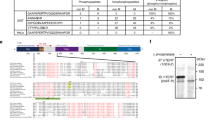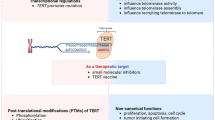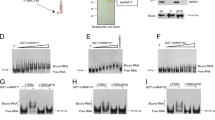Abstract
In this study, we identified posttranslational regulation of human telomerase reverse-transcriptase (hTERT) by the E3 ligase Hdm2. The telomerase activity generated by exogenous hTERT in U2OS cells was reduced on adriamycin treatment. The overexpressed levels of hTERT were also decreased under the same conditions. These processes were reversed by treatment with a proteasome inhibitor or depletion of Hdm2. Furthermore, intrinsic telomerase activity was increased in HCT116 cells with ablation of Hdm2. Immunoprecipitation analyses showed that hTERT and Hdm2 bound to each other in multiple domains. Ubiquitination analyses showed that Hdm2 could polyubiquitinate hTERT principally at the N-terminus, which was further degraded in a proteasome-dependent manner. An hTERT mutant with all five lysine residues at the N-terminus of hTERT that mutated to arginine became resistant to Hdm2-mediated ubiquitination and degradation. In U2OS cells, depletion of Hdm2 or addition of the Hdm2-resistant hTERT mutant strengthened the cellular protective effects against apoptosis. Similar results were obtained with the Hdm2-stable H1299 cell line. These observations indicate that Hdm2 is an E3 ligase of hTERT.
This is a preview of subscription content, access via your institution
Access options
Subscribe to this journal
Receive 50 print issues and online access
$259.00 per year
only $5.18 per issue
Buy this article
- Purchase on Springer Link
- Instant access to full article PDF
Prices may be subject to local taxes which are calculated during checkout








Similar content being viewed by others
References
Akiyama M, Hideshima T, Hayashi T, Tai YT, Mitsiades CS, Mitsiades N et al. (2002). Cytokines modulate telomerase activity in a human multiple myeloma cell line. Cancer Res 62: 3876–3882.
Blackburn EH . (2000). The end of the (DNA) line. Nat Struct Biol 7: 847–850.
Blasco MA . (2003). Telomeres and cancer: a tale with many endings. Curr Opin Genet Dev 13: 70–76.
Bodnar AG, Ouellette M, Frolkis M, Holt SE, Chiu CP, Morin GB et al. (1998). Extension of life-span by introduction of telomerase into normal human cells. Science 279: 349–352.
Bouska A, Eischen CM . (2009). Murine double minute 2: p53-independent roads lead to genome instability or death. Trends Biochem Sci 34: 279–286.
Brooks CL, Gu W . (2006). p53 ubiquitination: Mdm2 and beyond. Mol Cell 21: 307–315.
Cairney CJ, Keith WN . (2008). Telomerase redefined: integrated regulation of hTR and hTERT for telomere maintenance and telomerase activity. Biochimie 90: 13–23.
Camus S, Menendez S, Cheok CF, Stevenson LF, Lain S, Lane DP . (2007). Ubiquitin-independent degradation of p53 mediated by high-risk human papillomavirus protein E6. Oncogene 26: 4059–4070.
Cao Y, Li H, Deb S, Liu JP . (2002). TERT regulates cell survival independent of telomerase enzymatic activity. Oncogene 21: 3130–3138.
Carroll VA, Ashcroft M . (2008). Regulation of angiogenic factors by HDM2 in renal cell carcinoma. Cancer Res 68: 545–552.
Cong Y, Shay JW . (2008). Actions of human telomerase beyond telomeres. Cell Res 18: 725–732.
Cong YS, Wright WE, Shay JW . (2002). Human telomerase and its regulation. Microbiol Mol Biol Rev 66: 407–425. table of contents.
Counter CM, Meyerson M, Eaton EN, Ellisen LW, Caddle SD, Haber DA et al. (1998). Telomerase activity is restored in human cells by ectopic expression of hTERT (hEST2), the catalytic subunit of telomerase. Oncogene 16: 1217–1222.
Dairkee SH, Nicolau M, Sayeed A, Champion S, Ji Y, Moore DH et al. (2007). Oxidative stress pathways highlighted in tumor cell immortalization: association with breast cancer outcome. Oncogene 26: 6269–6279.
Dalla Torre CA, Maciel RM, Pinheiro NA, Andrade JA, De Toledo SR, Villa LL et al. (2002). TRAP-silver staining, a highly sensitive assay for measuring telomerase activity in tumor tissue and cell lines. Braz J Med Biol Res 35: 65–68.
de Lange T . (2005). Shelterin: the protein complex that shapes and safeguards human telomeres. Genes Dev 19: 2100–2110.
Dimri GP, Martinez JL, Jacobs JJ, Keblusek P, Itahana K, Van Lohuizen M et al. (2002). The Bmi-1 oncogene induces telomerase activity and immortalizes human mammary epithelial cells. Cancer Res 62: 4736–4745.
Enge M, Bao W, Hedstrom E, Jackson SP, Moumen A, Selivanova G . (2009). MDM2-dependent downregulation of p21 and hnRNP K provides a switch between apoptosis and growth arrest induced by pharmacologically activated p53. Cancer Cell 15: 171–183.
Froment P, Dupont J, Christophe-Marine J . (2008). Mdm2 exerts pro-apoptotic activities by antagonizing insulin-like growth factor-I-mediated survival. Cell Cycle 7: 3098–3103.
Hahn WC, Counter CM, Lundberg AS, Beijersbergen RL, Brooks MW, Weinberg RA . (1999). Creation of human tumour cells with defined genetic elements. Nature 400: 464–468.
Harley CB . (2008). Telomerase and cancer therapeutics. Nat Rev Cancer 8: 167–179.
Kanaya T, Kyo S, Hamada K, Takakura M, Kitagawa Y, Harada H et al. (2000). Adenoviral expression of p53 represses telomerase activity through down-regulation of human telomerase reverse transcriptase transcription. Clin Cancer Res 6: 1239–1247.
Kim JH, Park SM, Kang MR, Oh SY, Lee TH, Muller MT et al. (2005). Ubiquitin ligase MKRN1 modulates telomere length homeostasis through a proteolysis of hTERT. Genes Dev 19: 776–781.
Kim NW, Wu F . (1997). Advances in quantification and characterization of telomerase activity by the telomeric repeat amplification protocol (TRAP). Nucleic Acids Res 25: 2595–2597.
Kusumoto M, Ogawa T, Mizumoto K, Ueno H, Niiyama H, Sato N et al. (1999). Adenovirus-mediated p53 gene transduction inhibits telomerase activity independent of its effects on cell cycle arrest and apoptosis in human pancreatic cancer cells. Clin Cancer Res 5: 2140–2147.
Kyo S, Takakura M, Taira T, Kanaya T, Itoh H, Yutsudo M et al. (2000). Sp1 cooperates with c-Myc to activate transcription of the human telomerase reverse transcriptase gene (hTERT). Nucleic Acids Res 28: 669–677.
Luiten RM, Pene J, Yssel H, Spits H . (2003). Ectopic hTERT expression extends the life span of human CD4+ helper and regulatory T-cell clones and confers resistance to oxidative stress-induced apoptosis. Blood 101: 4512–4519.
Maser RS, DePinho RA . (2002). Connecting chromosomes, crisis, and cancer. Science 297: 565–569.
McEachern MJ, Krauskopf A, Blackburn EH . (2000). Telomeres and their control. Annu Rev Genet 34: 331–358.
Oh W, Ghim J, Lee EW, Yang MR, Kim ET, Ahn JH et al. (2009). PML-IV functions as a negative regulator of telomerase by interacting with TERT. J Cell Sci 122: 2613–2622.
Oh W, Lee EW, Sung YH, Yang MR, Ghim J, Lee HW et al. (2006). Jab1 induces the cytoplasmic localization and degradation of p53 in coordination with Hdm2. J Biol Chem 281: 17457–17465.
Rahman R, Latonen L, Wiman KG . (2005). hTERT antagonizes p53-induced apoptosis independently of telomerase activity. Oncogene 24: 1320–1327.
Roth A, Yssel H, Pene J, Chavez EA, Schertzer M, Lansdorp PM et al. (2003). Telomerase levels control the lifespan of human T lymphocytes. Blood 102: 849–857.
Saller E, Tom E, Brunori M, Otter M, Estreicher A, Mack DH et al. (1999). Increased apoptosis induction by 121F mutant p53. EMBO J 18: 4424–4437.
Shats I, Milyavsky M, Tang X, Stambolsky P, Erez N, Brosh R et al. (2004). p53-dependent down-regulation of telomerase is mediated by p21waf1. J Biol Chem 279: 50976–50985.
Teng L, Specht MC, Barden CB, Fahey III TJ . (2003). Antisense hTERT inhibits thyroid cancer cell growth. J Clin Endocrinol Metab 88: 1362–1366.
Urquidi V, Tarin D, Goodison S . (2000). Role of telomerase in cell senescence and oncogenesis. Annu Rev Med 51: 65–79.
Vaziri H, Benchimol S . (1998). Reconstitution of telomerase activity in normal human cells leads to elongation of telomeres and extended replicative life span. Curr Biol 8: 279–282.
Veldman T, Horikawa I, Barrett JC, Schlegel R . (2001). Transcriptional activation of the telomerase hTERT gene by human papillomavirus type 16 E6 oncoprotein. J Virol 75: 4467–4472.
Wang SP, Wang WL, Chang YL, Wu CT, Chao YC, Kao SH et al. (2009). p53 controls cancer cell invasion by inducing the MDM2-mediated degradation of Slug. Nat Cell Biol 11: 694–704.
Wu YL, Dudognon C, Nguyen E, Hillion J, Pendino F, Tarkanyi I et al. (2006). Immunodetection of human telomerase reverse-transcriptase (hTERT) re-appraised: nucleolin and telomerase cross paths. J Cell Sci 119: 2797–2806.
Xu D, Wang Q, Gruber A, Bjorkholm M, Chen Z, Zaid A et al. (2000). Downregulation of telomerase reverse transcriptase mRNA expression by wild type p53 in human tumor cells. Oncogene 19: 5123–5133.
Zhang X, Mar V, Zhou W, Harrington L, Robinson MO . (1999). Telomere shortening and apoptosis in telomerase-inhibited human tumor cells. Genes Dev 13: 2388–2399.
Zhang Z, Zhang R . (2005). p53-independent activities of MDM2 and their relevance to cancer therapy. Curr Cancer Drug Targets 5: 9–20.
Acknowledgements
This work was supported by a grant from the National R&D Program for Cancer Control, Ministry of Health and Welfare, Republic of Korea (0820110) and by a grant of the Korea Healthcare technology R&D Project, Ministry of Health and Welfare, Republic of Korea (A080333).
Author information
Authors and Affiliations
Corresponding author
Ethics declarations
Competing interests
The authors declare no conflict of interest.
Additional information
Supplementary Information accompanies the paper on the Oncogene website
Supplementary information
Rights and permissions
About this article
Cite this article
Oh, W., Lee, EW., Lee, D. et al. Hdm2 negatively regulates telomerase activity by functioning as an E3 ligase of hTERT. Oncogene 29, 4101–4112 (2010). https://doi.org/10.1038/onc.2010.160
Received:
Revised:
Accepted:
Published:
Issue Date:
DOI: https://doi.org/10.1038/onc.2010.160
Keywords
This article is cited by
-
Diverse regulatory manners of human telomerase reverse transcriptase
Cell Communication and Signaling (2019)
-
Tandem affinity purification of AtTERT reveals putative interaction partners of plant telomerase in vivo
Protoplasma (2017)
-
Neuropilin-2 expression is inhibited by secreted Wnt antagonists and its down-regulation is associated with reduced tumor growth and metastasis in osteosarcoma
Molecular Cancer (2015)
-
MDM2’s social network
Oncogene (2014)
-
The putative tumor suppressor C53 interacts with the human telomerase reverse transcriptase hTERT and regulates telomerase activity
Chinese Science Bulletin (2014)



